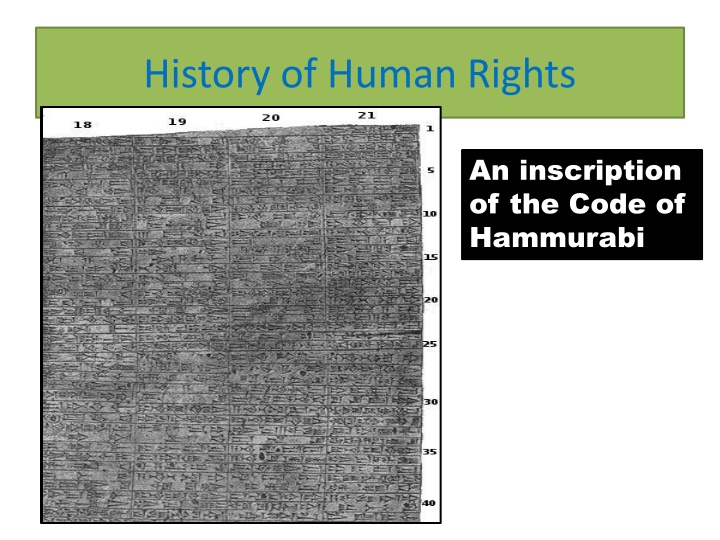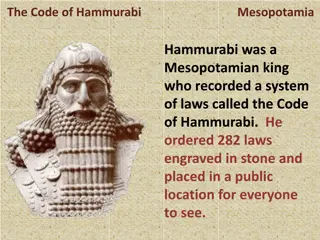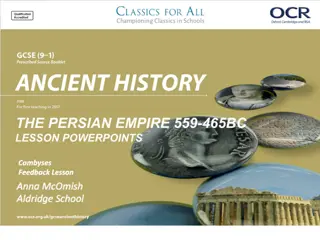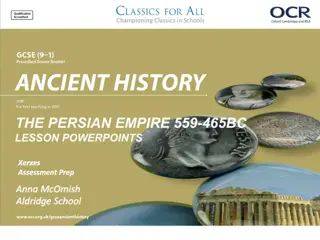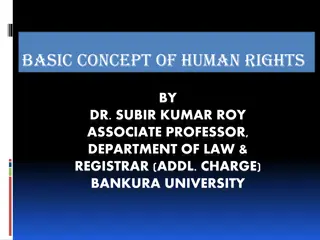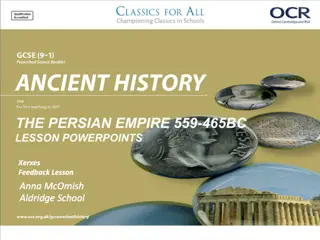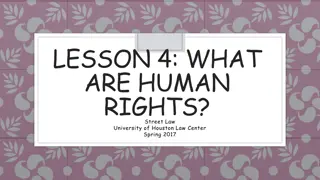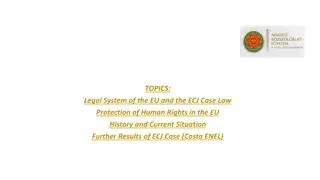Ancient Origins of Human Rights: Code of Hammurabi to Cyrus the Great
Explore the historical roots of human rights, starting from the Code of Hammurabi in Mesopotamia, through the reforms of Urukagina and the Neo-Sumerian Code of Ur-Nammu, to the groundbreaking principles established by Cyrus the Great in the Achaemenid Persian Empire. Witness the evolution of human rights through ancient legal codes and declarations, such as the Cyrus Cylinder and Edicts of Ashoka, reflecting early concepts of equality, justice, and religious tolerance.
Download Presentation

Please find below an Image/Link to download the presentation.
The content on the website is provided AS IS for your information and personal use only. It may not be sold, licensed, or shared on other websites without obtaining consent from the author.If you encounter any issues during the download, it is possible that the publisher has removed the file from their server.
You are allowed to download the files provided on this website for personal or commercial use, subject to the condition that they are used lawfully. All files are the property of their respective owners.
The content on the website is provided AS IS for your information and personal use only. It may not be sold, licensed, or shared on other websites without obtaining consent from the author.
E N D
Presentation Transcript
History of Human Rights An inscription of the Code of Hammurabi
The reforms of Urukagina of Lagash, the earliest known legal code (2350 BC) was no reformer at all. to curb the encroachment of a secular authority at the expense of temple prerogatives The oldest legal codex extant today is the Neo- Sumerian Code of Ur-Nammu (ca. 2050 BC) Mesopotamia, including the Code of Hammurabi (ca. 1780 BC).
the most famous examples of this type of document. It shows rules, and punishments including women's rights, men's rights, children's rights and slave rights.
The Cyrus Cylinder of Cyrus the Great, founder of the Achaemenid Persian Empire
Achaemenid Persian Empire of ancient Iran established unprecedented principles of human rights in the 6th century BC under Cyrus the Great. After his conquest of Babylon in 539 BC, the king issued the Cyrus cylinder, discovered in 1879 and seen by some today as the first human rights document. Books of Chronicles, Nehemiah, and Ezra, which state that Cyrus allowed (at least some of) the Jews to return to their homeland from their Babylonian Captivity.
the Cylinder as a "charter of human rights The cylinder now lies in the British Museum.
Citizenship beginning in ancient Greece, where all citizens had the right to speak and vote in the political assembly. The Twelve Tables Law established the principle "Privilegia ne irroganto", which literally means "privileges shall not be imposed". A declaration for religious tolerance on an egalitarian basis can be found in the Edicts of Ashoka,
Edict of Ashoka 6th Pillar Edicts of Ashoka- described Moral Behaviour
The slaughter or capture of prisoners of war was also condemned by Ashoka. the Sanskrit Laws of Manu of the 1st century BC
Muhammad preached against what he saw as the social evils of his day. Islamic social reforms in areas such as social security, family structure, slavery, and the rights of women and ethnic minorities, female infanticide, exploitation of the poor, murder, false contracts, and theft. Mosaic laws and customs of the time into his divine revelations.
Constitution of Medina, also known as the Charter of Medina, was drafted by Muhammad in 622. Middle Ages Magna Carta is an English charter originally issued in 1215 which development of the common law and many later constitutional documents, such as the United States Constitution and the Bill of Rights. influenced the
Magna Carta was originally written because of disagreements amongst Pope Innocent III, King John and the English barons about the rights of the King. habeas corpus, No Freeman shall be taken or imprisoned, or be disseised of his Freehold, or Liberties, or free Customs, or be outlawed, or exiled, or any other wise destroyed; nor will We not pass upon him, nor condemn him, but by lawful judgment of his Peers, or by the Law of the Land. We will sell to no man, we will not deny or defer to any man either Justice or Right. Clause XXIX of the Magna Carta (clauses 36, 38, 39, and 40 of the 1215 )
Magna Carta (British Library Cotton MS Augustus II-1215 AD)
Modern human rights movement Age of Discovery, early modern period and Age of Enlightenment. 15th and 16th centuries by Spain, during the Age of Discovery, resulted in vigorous debate about human rights in Colonial Spanish America. The sermon, known as the Christmas Sermon, gave way to further debates from 1550-51
U.S. Declaration of Independence ratified by the Continental Congress on July 4, 1776
Several 17th- and 18th-cent European philosophers, like John Locke, developed the concept of natural rights, the notion that people are naturally free and equal. Though Locke believed natural rights were derived from divinity since humans were creations of God, his ideas were important in the development of the modern notion of rights. in 1689, the English Bill of Rights was created which asserted some basic human rights, most famously freedom from cruel and unusual punishment
Novels-Julie, or the New Heloise by Jean- Jacques Rousseau and Pamela; or Virtue Rewarded by Samuel Richardson, laid a foundation for popular acceptance of human rights. Two major revolutions occurred during the 18th century in the United States (1776) and in France (1789). The Virginia Declaration of Rights of 1776 sets up a number of fundamental rights later United States Independence and freedoms. Declaration The of
states "that all men are created equal, that they are endowed by their Creator with certain unalienable rights, that among these are life, liberty and the pursuit of happiness". Similarly, the French Declaration of the Rights of Man and Citizen defines a set of individual and collective rights of the people. These are, in the document, held to be universal not only to French citizens but to all men without exception.
19th century to World War I Philosophers such as Thomas Paine, John Stuart Mill and Hegel expanded on the theme of universality during the 18th and 19th centuries. In 1831 William Lloyd Garrison wrote in a newspaper called The Liberator that he was trying to enlist his readers in "the great cause of human rights
Declaration of the Rights of Man and of the Citizen approved by the National Assembly of France, August 26, 1789
Rights in War and the Geneva Conventions Original Geneva Convention in 1864 Progression of Geneva Conventions from 1864 to 1949 Henry Dunant, the founder of GC the International Committee of the Red Cross laws of war. 4 GC were organised
Between World War I and World War II The League of Nations was established in 1919 at the negotiations over the Treaty of Versailles following the end of World War I. The League's goals included disarmament, preventing war through collective security, settling disputes between countries through negotiation, diplomacy and improving global welfare
"It is not a treaty...[In the future, it] may well become the international Magna Carta."[49] Eleanor Roosevelt with the Spanish text of the Universal Declaration in 1949
Universal Declaration of Human Rights UDHR declaration adopted by the United Nations General Assembly in 1948. ...recognition of the inherent dignity and of the equal and inalienable rights of all members of the human family is the foundation of freedom, justice and peace in the world Preamble to the Universal Declaration of Human Rights, 1948
The inclusion of both civil and political rights and economic, social and cultural rights. Eleanor Roosevelt as Chair, who began to discuss an International Bill of Rights in 1947. Later histories Human right was included in point VII of Helsinki Accords, which was signed in 1975 by thirty-five states
During his inaugural speech in 1977, the 39th President of United States Jimmy Carter made human rights a pillar of United States foreign policy. Human rights advocacy organization Amnesty International later won Nobel Peace Prize also in 1977. won Nobel Peace Prize in 2002 human rights, and to promote economic and social development
